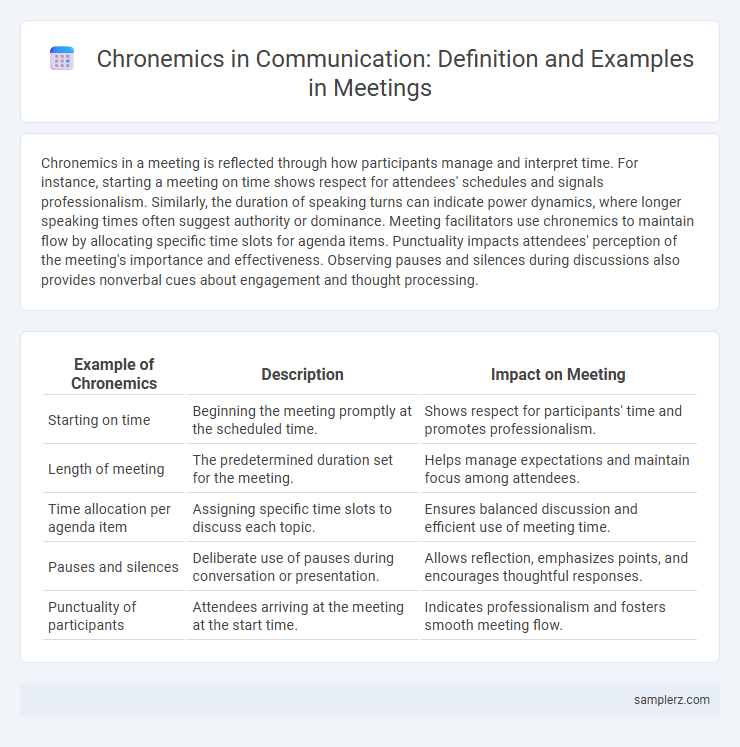Chronemics in a meeting is reflected through how participants manage and interpret time. For instance, starting a meeting on time shows respect for attendees' schedules and signals professionalism. Similarly, the duration of speaking turns can indicate power dynamics, where longer speaking times often suggest authority or dominance. Meeting facilitators use chronemics to maintain flow by allocating specific time slots for agenda items. Punctuality impacts attendees' perception of the meeting's importance and effectiveness. Observing pauses and silences during discussions also provides nonverbal cues about engagement and thought processing.
Table of Comparison
| Example of Chronemics | Description | Impact on Meeting |
|---|---|---|
| Starting on time | Beginning the meeting promptly at the scheduled time. | Shows respect for participants' time and promotes professionalism. |
| Length of meeting | The predetermined duration set for the meeting. | Helps manage expectations and maintain focus among attendees. |
| Time allocation per agenda item | Assigning specific time slots to discuss each topic. | Ensures balanced discussion and efficient use of meeting time. |
| Pauses and silences | Deliberate use of pauses during conversation or presentation. | Allows reflection, emphasizes points, and encourages thoughtful responses. |
| Punctuality of participants | Attendees arriving at the meeting at the start time. | Indicates professionalism and fosters smooth meeting flow. |
Understanding Chronemics: The Role of Time in Meetings
Effective meetings often rely on the strategic use of chronemics, where the allocation of time signals importance and urgency to participants. For instance, starting a meeting precisely on time demonstrates respect for attendees' schedules and fosters a culture of punctuality. Similarly, the pacing of agenda items communicates priority, with longer discussions reserved for critical topics and brief updates signaling lesser importance.
Early Arrivals: Punctuality as a Communication Cue
Early arrivals in meetings serve as a powerful nonverbal communication cue that conveys respect, enthusiasm, and preparedness. Punctuality signals a participant's commitment and reliability, influencing group dynamics and setting a tone of professionalism. Observing and interpreting these temporal behaviors can enhance understanding of individual attitudes and the overall organizational culture.
Late Participants: The Message Behind Tardiness
Late participants in meetings often communicate disrespect or lack of commitment through their tardiness, impacting group dynamics and productivity. In chronemics, this delay signals a disruption in time management and can indicate underlying issues such as poor prioritization or inadequate preparation. Understanding the message behind tardiness helps address punctuality norms and reinforces effective communication within professional settings.
Time Allocation: Speaking Time as Power Dynamics
In meetings, chronemics reveals power dynamics through speaking time allocation, where individuals who dominate the conversation often assert authority and influence decisions. Research indicates that leaders typically control over 70% of speaking time, signaling status and control within group interactions. Unequal time distribution can impact participation, with less speaking time correlating to decreased engagement and perceived lower status among team members.
Scheduling Patterns: Cultural Perceptions of Meeting Times
Scheduling patterns in meetings reveal significant cultural perceptions of time, where monochronic cultures prioritize strict adherence to start and end times, valuing punctuality and linear time management. Polychronic cultures exhibit flexible meeting structures, often allowing interruptions and multitasking, emphasizing relationships over rigid schedules. Understanding these chronemics differences enhances cross-cultural communication effectiveness by aligning meeting expectations with participants' temporal preferences.
Managing Interruptions: Temporal Flow and Respect
Managing interruptions in meetings through chronemics involves controlling the timing and duration of interruptions to maintain the temporal flow and show respect for participants. Allowing brief, well-timed interjections preserves the meeting's structure while preventing dominance or disruption. Effective chronemic practices enhance communication by balancing turn-taking and minimizing temporal conflicts.
Turn-Taking: Temporal Order in Conversation
Turn-taking in meetings demonstrates chronemics through the temporal order of conversation, where speakers alternate speaking turns to maintain flow and avoid overlap. Precise timing in responses signals attentiveness and respect for others' contributions, optimizing collaborative communication. Interruptions or delayed responses disrupt this temporal rhythm, potentially causing misunderstandings and reducing meeting effectiveness.
Meeting Duration: Implications on Engagement and Productivity
Meeting duration significantly influences participant engagement and overall productivity, with excessively long meetings often causing cognitive fatigue and reduced attention. Effective chronemics involve scheduling concise sessions, typically under 60 minutes, to maintain focus and facilitate active participation. Proper management of time cues during meetings enhances communication flow, ensuring that key objectives are addressed efficiently without overwhelming attendees.
Use of Breaks: Chronemic Signals in Meeting Structure
Breaks strategically placed during meetings serve as vital chronemic signals that regulate pacing, enhance information processing, and facilitate cognitive reset. These time pauses implicitly communicate importance, indicate transitions between agenda items, and offer nonverbal cues about group dynamics and priorities. Effective use of breaks improves attentiveness and collaboration, optimizing overall meeting efficiency through controlled temporal structuring.
Closing Rituals: Time Management at Meeting End
Closing rituals in meetings often involve specific chronemics, such as allocating the final five minutes for summary and action items to signal the session's end. Time management cues like deliberately slowing speech or pausing emphasize the transition from discussion to closure. These temporal behaviors help participants recognize the meeting's conclusion and prepare for departure efficiently.

example of chronemics in meeting Infographic
 samplerz.com
samplerz.com